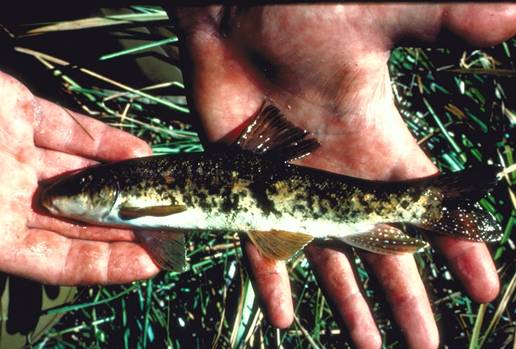Lahontan Mountain Sucker
-
Scientific NameCatostomus platyrhynchus
-
NativeYes
-
Identification
 Mountain sucker. Photo courtesy of Professor Peter B. Moyle.
Mountain sucker. Photo courtesy of Professor Peter B. Moyle.- Small, fusiform sucker, up to 23 cm TL
- Subterminal mouth, fleshy lips with papillae
- Upper and lower lips notched at lateral margins, lower lip has median “cleft”
- Front of upper lip lacks papillae
- Lower lip lacks papillae in two semi-circles on inner margin, cartilaginous scraper may be evident
- Coloration: Brown to olive back and sides, white to yellow underside, lateral band of splotches usually present
- Mature males: dark red-orange lateral band above black-green lateral band
- Spawning males: red-orange fins present, breeding tubercles cover entire body and all fins except dorsal, tubercles prominent on anal fin
- Spawning females: tubercles present on back and sides of head and body
- Fin rays: dorsal 8-13, pelvic 9
- Lateral line scales: 75-92
-
Life History
Mountain Suckers are appropriately named as these fish are found predominately in cool mountain streams with a temperature range of 1-28°C. In California the Mountain Sucker is native to several drainages on the eastern slope of the Sierra, though it has also been found in the Feather River watershed. They are usually found in clear mountain streams with a moderate gradient and a stream substrate composed of boulders, sand, or rubble. Mountain Suckers also live in large rivers, turbid streams, and lakes. In California they are often found in association with Tahoe Suckers and Speckled Dace, though the Mountain Sucker typically isolates itself form other Sucker species. Within a stream Mountain Suckers favor pools with ample cover in the form of logs, overhanging banks, and aquatic vegetation. Juveniles feed on algae, diatoms, insects, and other aquatic invertebrates whereas adults tend to consume a smaller proportion of insects. The growth rate of the Mountain Sucker is greatest in the first year of life with females eventually reaching larger sizes than the male Suckers. Male Suckers reach sexual maturity in year 2-3 of a maximum 7 year life span, and females reach sexual maturity in year 3-4 of a possible 9 year life span. Spawning happens between June and early August in gravelly riffles of small streams when Suckers move into those reaches to feed on algae. The act of spawning likely occurs at night when water temperatures are in a range of 11-19°C. Fertilized eggs fall into and adhere to the spaces between the gravel composite.
-
Links to Other ResearchN / A
